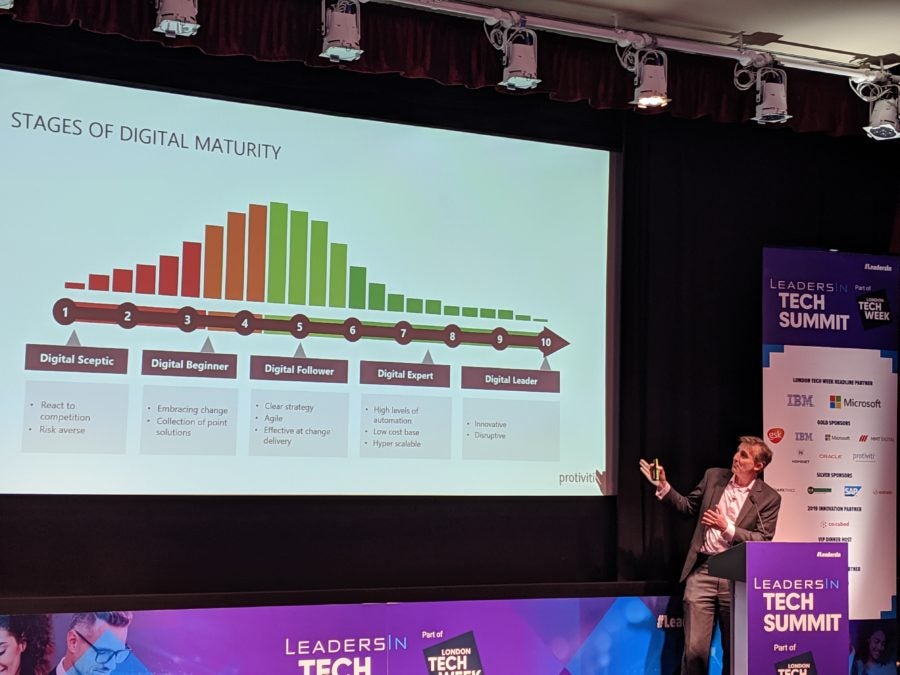
Digital transformation, in which an organisation employs digital technology to solve traditional problems and improve efficiency, can often become a hot mess of buzzword soup.
Blockhain. AI. Automation. Emerging technologies. It’s time to forget these buzzwords – successful digital transformation is all about mindset, according to Jonathan Wyatt, global head of digital innovation at global consulting firm Protiviti Digital.
“It’s fundamentally about changing the way the organisation thinks. Changing the way the organisation acts,” said Wyatt, speaking earlier this month at the Digital Leaders Summit, a London Tech Week event.
“If you can change the way the organisation acts and thinks, if you can educate the organisation on the possibilities that digital technologies bring, the organisation will embrace it. If you force the technology on an organisation that’s not ready you do not get the desired result.”
Wyatt warned against the danger of so-called point solutions, where technology solves one specific problem without addressing the wider issues.
This, he said, results in a “digital veneer” that gives the impression a business is being transformed, but in reality, it’s not addressing the underlying issues.
How well do you really know your competitors?
Access the most comprehensive Company Profiles on the market, powered by GlobalData. Save hours of research. Gain competitive edge.

Thank you!
Your download email will arrive shortly
Not ready to buy yet? Download a free sample
We are confident about the unique quality of our Company Profiles. However, we want you to make the most beneficial decision for your business, so we offer a free sample that you can download by submitting the below form
By GlobalData“They’re not changing their business from the inside out,” he explained. “They are doing things to react to what’s going on around them, which results in this digital veneer.”
One example is a retailer creating a website and a mobile app. The solutions may be digital, but by only addressing a small part of the business, it hasn’t become a digital retailer.
By contrast, companies such as Amazon have embraced technology across their business, from logistics to customer service.
“A true digital transformation is one that starts at the heart of the organisation, starts at the core, and tries to change the way an organisation thinks, not one that puts the veneer around the outside.”
Such a digital veneer may have some short term results, he said, but in the long term, it will not result in a true digital transformation.
The myriad stages of digital transformation
Businesses can find themselves in different stages of their digital transformation journey.
The first group, according to Wyatt, is the digital sceptics. This group may be embracing technology but “haven’t quite got themselves to a point of recognising that what they choose to do and how they utilise digital technologies is what will determine their success in the future”.
These risk-averse organisations tend to embrace digital technologies because “they feel they have to”.
“They’re not looking at the new digital age and thinking of all the possibilities and opportunities it presents,” said Wyatt.
The next stage is the beginners. These are organisations that have “recognised the opportunity that the digital economy presents”.
This group is experimenting and having some success with technology, but lacking a “coherent vision” and strategy as to “how they are going to be the leader in the digital age”.
The next level is the followers, who have a vision and are making progress but “recognise how far they’ve got to go”.
This agile group is “quick at affecting change” and are fast to react, but there is a “significant difference” between the next level up – the experts.
Experts have “very high levels of automation within their business” and are hyper-scalable, allowing them to double or shrink overnight to match demand.
The final group is the leaders, who are experts that “layer in disruptive thinking”. Their brand will be “associated with disruption in the industry in which they sit”.
Most organisations are in the beginner and follower categories, according to Protiviti research.

Six digital transformation tips for success
- “Digital leadership is all about mindset. It’s about state of mind, it’s about getting the organisation to act and think digital in everything that it does, in every decision it takes.” This means the entire organisation – “It’s no good being an organisation of 100,000 people where you have a digital team of one or two thousand,” says Wyatt.
- “True digital transformation starts at the core. That’s not to say you don’t do the veneer things – you have to do the veneer things. But you’ve got to do the things that are going to change the way the organisation thinks from the inside out. Because if you don’t do that, you won’t affect the change you want.”
- “People and culture are key. You lead with people, you lead with culture, you don’t lead with technology. Technology is a result of a mindset of the people and an understanding and therefore people embracing seeing the opportunities and taking advantage of that.
- “You need to know your limitations.” What might work for one organisation won’t necessarily work for another. Carrying out an assessment at the start of the digital journey can ensure the limitations are known from the outset.
- “You can’t put off the difficult decisions. And that’s where a lot of organisations start to go wrong, when they see the hurdle ahead, that I’ve got this quarter, I’ve got to deal with this.” Having a plan and a vision to manage these will ensure success.
- “You need an approach for measuring progress.” That can be a scorecard that monitors the digital transformation journey over time.
Read more: Three tips to create a culture of productive disruption from a Google exec







